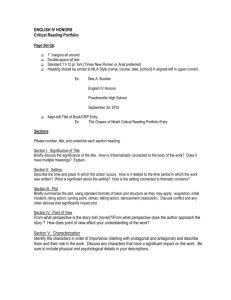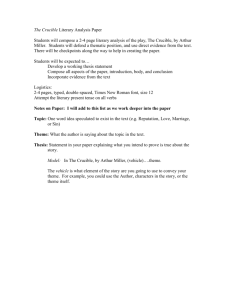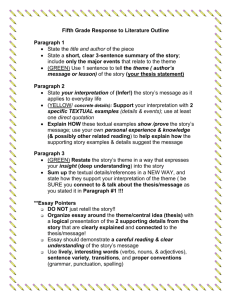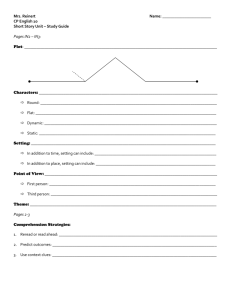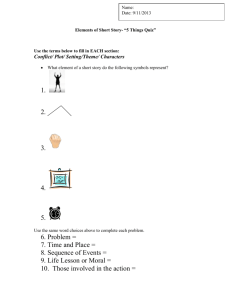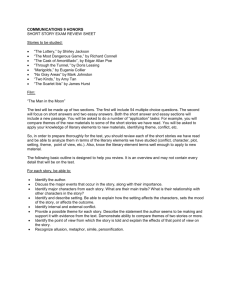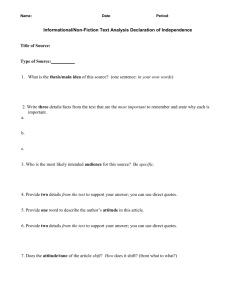Literary Analysis - River Dell Regional School District
advertisement
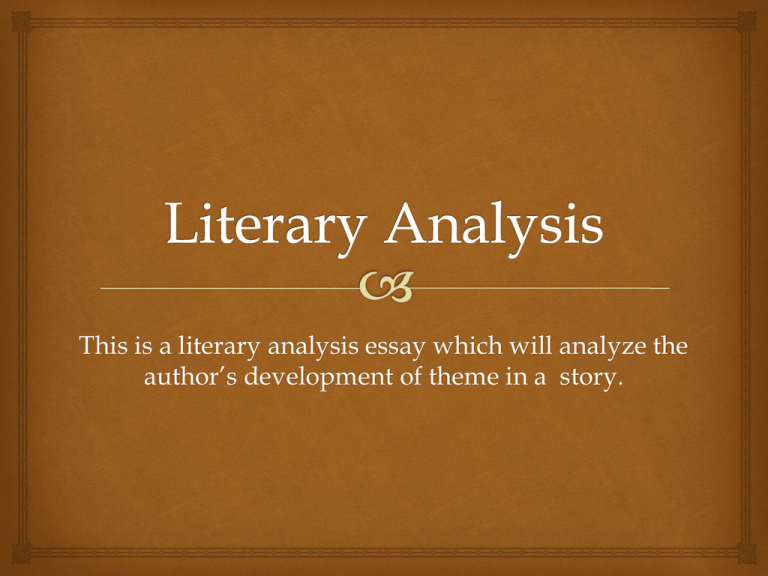
This is a literary analysis essay which will analyze the author’s development of theme in a story. Introduction The introduction must introduce the author (William Golding) the title of the story (Lord of the Flies) provide a brief plot summary (one or two sentences) state the theme of the story, and explain which literary device(s) the author uses to develop the theme.(For example: Through character development and setting description, Golding shows readers that . . .) Introduction Edward P. Jones’ The First Day develops the theme that most parents will do whatever it takes to ensure that their children are successful and avoid making the same mistakes that they did. In this story of a working-class girl’s first day of school, the author’s characterization of the mother supports this theme. the author the title of the story provide a brief plot summary state the theme of the story explain which literary device(s) the author uses to develop the theme Examples of literary devices: How does the author use literary devices to develop the theme of the story? Consider one or more of the following: Setting Characterization (character’s actions, inner thoughts and motivation. Is the character dynamic?) Point of view (who is telling the story?) Symbolism Plot (conflict, climax, resolution) Diction Figurative language Other craft techniques Body Paragraphs Each body paragraph must refer to a/the literary device and how the author uses the device to develop the theme. (For example: The conflict in “The Most Dangerous Game” reveals the theme that we can not understand another’s perspective until we have experienced his perspective. This paragraph would then discuss HOW the conflict reveals the theme using a quote(s) from the text as additional support.) Quotes Each body paragraph must include at least one quote and must follow proper format for integrating quotes. Body Paragraphs with Quotes The narrator’s mother has long planned for her daughter to attend Seaton, telling her since birth, “’You gonna go there and learn about the whole world’” (Jones 2). After being told they do not live in the Seaton area and, therefore cannot attend, the mother reluctantly pushes on, saying, “’One monkey don’t stop no show’” (Jones 2). These moments reveal the mother’s focus on her daughter’s education and her determination to overcome obstacles. Additionally, the mother’s use of colloquial diction—“gonna” and “don’t stop no show”— reveal her lack of education. Clearly, this mother is unwavering in her resolve to have her daughter succeed where she did not. Plot details are provided. Relevant quotes are used to support the thesis. Writer explains HOW the chosen quotes support the thesis. This is the analysis. Transition words are used! More Body Paragraphs . . . Later, the mother is forced to directly reveal her own mistakes when she has to ask another woman for help completing enrollment forms. She admits, “’I can’t read it. I don’t know how to read or write, and I’m askin you to help me” (Jones 3). This moment is given further impact when the narrator notes that her “mother is now diseased, according to [another] girl’s eyes” (Jones 3). Here the reader is able to experience the mother’s shame as she perseveres in her efforts to enroll her daughter in a good school. Clearly her illiteracy is not something she wants to publicly admit, but she is willing to do whatever it takes to help her daughter get educated, even if it means admitting her own shortcomings and subjecting herself to feelings of humiliation. Plot details are provided. Relevant quotes are used to support the thesis. Writer explains HOW the chosen quotes support the thesis. This is the analysis. Transition Conclusion The conclusion must restate the thesis and summarize the impact of the theme on the reader. The idea that parents want their children to succeed is not new, but Jones’ story brings it to life with vivid characterization , diction and poignant moments. Parenting isn’t easy, and for all her failings, this mother is one to admire. Details This is at least a five paragraph essay. DO NOT use personal pronouns (I, my, me, you, your) or contractions (can’t, won’t, don’t, doesn’t). The entire paper must be written in present tense (Jekyll explains in his final statement his motives for his experiment). You must use a minimum of six direct quotes. That is, at least two for each body paragraph. All quotations must be cited in MLA format. REMEMBER > > > A good literary analysis has the following components: *It has a solid and unique thesis statement that clearly is arguable. Your goal is to prove this thesis statement! *It has a solid introduction, body, and conclusion. It uses effective transitions and the writer analyzes sufficient textual support from the book. *There is meaningful textual support in each body paragraph. *It contains a well-formatted works cited page. You may use Noodletools for this if necessary. Other helpful tips! 1. Write in the present tense 2. Normally, keep yourself out of your analysis; in other words, use the third person (no I or you). Some instructors may require or allow the first or second person in an informal analysis if the usage is consistent, however, so check with your instructor. Our paper is a formal analysis, so first and second person are NOT permitted. 3. Avoid summarizing the plot (i.e., retelling the story literally). Instead analyze (form a thesis about and explain) the story in literary terms. 4. Do not confuse characters' (in fiction or drama) or speakers' (in poetry) viewpoints with authors' viewpoints. 5. Support your points with many quotations and paraphrases, but write the majority of your paper in your own words with your own ideas. 6. Cite prose, poetry, drama, critics, and any other sources used according to specialized MLA standards. Visit this link for detailed instructions. (http://owl.english.purdue.edu/owl/resource/747/01/) 7. You are not required to consult any sources other than Lord of the Flies, but if you do, you must cite them!!! The following rules about parenthetical documentation can be found in the “Writers Inc.” book on page 260-263, but here are some highlights! *Parenthetical references look like this: “Sophomores are in need of more discipline”(Cohrs 44). Note: *There is nothing in the parenthesis other than the last name of the author and the page number. There is no punctuation of any kind, the first name is not mentioned, etc. *The period comes after the parenthesis. You do not need to keep the punctuation within the quote unless it is a ? Or !. *You should use parenthetical documentation for any type of citation; either direct (word for word) or indirect (paraphrased). Some other issues . . . *If you end a quote before you end your sentence put the parenthesis at the end of the sentence. EX: “Studies show that Sophomores, while cute, can have a really nasty bite” that may infect easily (Santerre 43). So, why do we do this anyway? *To give appropriate credit to a source of information. *To use as a reference for the Works Cited Page that you will learn how to develop appropriately. *To learn how to incorporate citation information naturally within the text rather than disrupting your paper.
